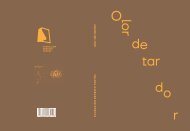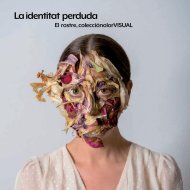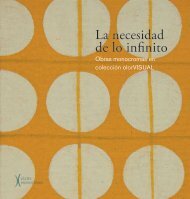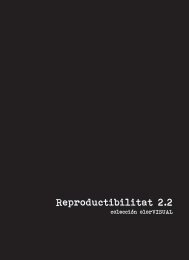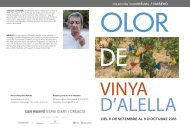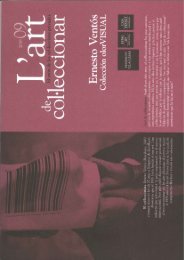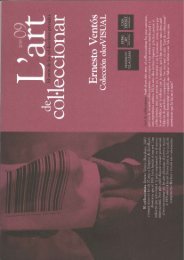24Electric
You also want an ePaper? Increase the reach of your titles
YUMPU automatically turns print PDFs into web optimized ePapers that Google loves.
cold as any other dead body but does not rot away,<br />
it remains here, inside its casket of gleaming wood,<br />
with its gleaming apparel, its skin red and gleaming,<br />
still, as if waiting to be photographed. Thus we know<br />
it is a saint. For that reason, and because it smells<br />
good. At first it smells of incense and white smoke,<br />
a very little, hardly at all. Then the aroma becomes<br />
more intense, and then it seems to smell of something<br />
else, like soap, and that soap makes its lather<br />
of smell, and its funeral smell, which are not seen,<br />
but the air carries them and they smell more and<br />
more. First they fill the church where the coffin lies<br />
and ascend the spiral staircase of the belfry. They perfume<br />
the streets and the squares and enter into the<br />
people’s houses and everybody realizes, even in the<br />
open fields outside the city, and in the paths of the<br />
thick forest, and on the river, on the hills and on the<br />
snow-covered mountains, in the lightless caves, on<br />
the beaches and on the cliffs of the coast, that that<br />
man was something more than a man because he<br />
died with a smell of sanctity.<br />
Jordi Galves<br />
70<br />
Linarejos Moreno<br />
‘I’ll never forget the smell of Andrew Freedman<br />
Home, I can still chew it. It was, without a doubt,<br />
the hardest project I’ve worked on.’ The director of<br />
that institution, which paradoxically called itself ‘No<br />
Longer Empty’, nodded, as if she too had that smell<br />
stuck in her throat, and went on to talk about the carpet<br />
and the junk.<br />
Two days earlier, when I was still working in the<br />
building, I had asked: ‘Do old people smell old because<br />
they are in old places or does this place smell<br />
old because it was full of old people?’ Laura, my disinterested<br />
assistant and shield against the ghosts,<br />
sighed, looked around and concentrated once more<br />
on the brush, the rabbit-skin glue and the fat.<br />
71<br />
Aitor Ortiz<br />
Smell is capable of invading any kind of space. A fragrance<br />
can be as fleeting as the coming and going of<br />
people.<br />
Other smells, in contrast, linger as long as the<br />
presence of the people who inhabit them. These are<br />
more complex; they are made up of successes and<br />
failures, of fights and celebrations, of noises and of<br />
silences.<br />
But what happens to spaces before they are lived<br />
in, before they are lived … when they are still virgin?<br />
Only someone who has been in these non-places<br />
knows the answer.<br />
72<br />
Leyla Cárdenas<br />
The sum of different layers of the work points both to<br />
absence and to presence. Or it translates the certainty<br />
of the encounter, which always implies an irremediable<br />
parallel loss.<br />
A space is the intersection of multiple times and<br />
places. I wonder, how does one manage to reflect all<br />
the places that have been? How to translate the multiple<br />
layers of a surface that is never just one surface?<br />
The place seems exhausted, but I stop to observe<br />
it, to smell it and listen to it. The sounds of its fall<br />
appear as in a successive network; sounds that in<br />
turn reconfigure the construction and then the<br />
house is drawn as a fragment. From the fragment a<br />
memory can be salvaged, accompanied by the persistence<br />
of its smells. And smells allow us at last to<br />
remember. When remembering is a sum of blurred<br />
images it is only possible to try to complete by superimposed<br />
layers.<br />
73<br />
Arancha Goyeneche<br />
The smell disappeared from my studio long ago.<br />
The aromas and fragrances of pigments, turpentine,<br />
oils… of pictures made with paint… have vanished.<br />
They have given way to aseptic, odourless materials<br />
such as vinyl adhesives and photography. Even so,<br />
the image I construct with them breathes in multiple<br />
sensations and emotions that refer us to this sense.<br />
74<br />
Anna Malagrida<br />
The windows mute,<br />
the memories of sand,<br />
the smell absent.<br />
Slowly the trace in the depths of the gaze.<br />
75<br />
Chema Alvargonzález<br />
Fire as what emerges from the process of becoming<br />
and disappearing.<br />
In the movement of the gaze through the places of<br />
the city the images are stored away in the passages<br />
of the memory, until a fire sparked off by the smell<br />
of the streets of the city (Barcelona) inundates the<br />
image I am observing and this image is reflected in<br />
the flames and the recollection burns in my memory.<br />
76<br />
Gregory Crewdson<br />
In Crewdson’s photographs (unlike in the cinema)<br />
the viewer always incorporates their own story, since<br />
in the end the image is left unresolved. Influenced by<br />
film, they have the capacity to show a frozen image,<br />
without us knowing what came before or what comes<br />
after... moments without a past or a future. As such,<br />
with no olfactory memory. Can we say that his photographs<br />
smell?<br />
Cristina Agàpito<br />
77<br />
Jacobo Castellano<br />
On smell…<br />
We cannot speak of the smell that these constructions<br />
give off without speaking of the stifling heat in<br />
this part of the Sahara desert.<br />
A variety of organic and inorganic elements are<br />
hung on the metal mesh that gives form to these<br />
corrals.<br />
Among these are the dried hides of the animals<br />
they slaughter for their own consumption. It is not<br />
difficult to imagine the putrid smell given off by the<br />
skins that are hung there until they have completely<br />
dried.<br />
The size of the corral also has a decisive influence<br />
on how it smells, first because the number of skins<br />
needed to protect the animals from the sun is greater<br />
and second because the number of goats is also<br />
greater, increasing the quantity of urine and dung<br />
heated by the asphyxiating desert sun.<br />
Rarely, if ever, are these corrals mucked out; the<br />
wind and the sandstorms do the job of blowing<br />
away the dung, or burying it in the case of the sandstorms.<br />
Finally, the lack of rain is the icing on the cake<br />
of climatological adversities that contribute to the<br />
bad smell, although at the same time they very<br />
much caught my attention thanks to their sculptural<br />
beauty.<br />
78<br />
Anna Ferrer<br />
Colombia occupies third place in the world ranking<br />
of countries with the greatest number of people displaced<br />
by violence, after Sudan and the Democratic<br />
Republic of the Congo.<br />
According to government estimates, there are two<br />
million internally displaced persons in Colombia, although<br />
NGOs believe that the figure may be closer to<br />
3.5 million people.<br />
Every day, thousands of people in the rural areas of<br />
the country flee violence, looting and persecution by<br />
guerrillas, but, above all, by paramilitaries or by the<br />
army itself, and move to the relative safety of Bogotá,<br />
in search of the protection that comes from anonymity<br />
among the masses.<br />
Altos de Cazucá is a group of neighbourhoods in<br />
the south of Bogotá that contains tens of thousands<br />
of internally displaced people.<br />
La Isla and El Oasis are two of these neighbourhoods.<br />
Most people cannot return to the homes they were<br />
forced to abandon, plundered by their victimizers,<br />
but at the same time they find it difficult to integrate<br />
into the big city, precisely because of their condition<br />
as displaced persons.<br />
The lack of opportunities makes young people easy<br />
prey for forced recruitment by the AUC (Autodefensas<br />
Unidas de Colombia or United Self-Defense Forces of<br />
Colombia, a right-wing paramilitary group tolerated<br />
by the government), which is massively present in the<br />
peripheral neighbourhoods.<br />
The large sums of money paid by the AUC, particularly<br />
to recruiters or informers, are very tempting.<br />
But many people simply have no alternative: forced<br />
recruitment targets unemployed young men. They<br />
are accused of roaming the streets, of supporting the<br />
leftist guerrillas or simply of being leftists, and those<br />
who refuse to join up are brutally murdered.<br />
It seems that the conflict is following its victims.<br />
April 06<br />
This smells bad<br />
On 11 May 2005, between 7.30 and 8 p.m., five heavily<br />
armed men went from house to house with lists<br />
in their hands asking for young men by name. In<br />
the El Oasis neighbourhood in Los Altos de Cazucá,<br />
three teenage boys were forced to lie face-down in<br />
the middle of the street and then each one was shot<br />
in the head. Michael Arranda, aged 14, and Omar<br />
Erminso Hernández, 16, were killed instantly, and<br />
Javier Vargas, 19, was mortally wounded. In other<br />
neighbourhoods of Los Altos de Cazucá, murders and<br />
disappearances were also reported, and residents<br />
speak of more than fifteen youths and minors killed<br />
in a weekend.<br />
These murders are part of a campaign of social<br />
terror that is accompanied by threats written on the<br />
walls of Los Altos de Cazucá that say: “put your children<br />
to bed early or we will put them to sleep”.<br />
On Saturdays at noon, when the main street of the<br />
neighbourhood of La Isla is full of children playing,<br />
men talking and women doing the weekly shopping<br />
of vegetables and rice, a score of young Afro-Colombians<br />
gather in front of the big green house of culture<br />
that an organization for displaced Afro-Colombians<br />
built thanks to a donation. (1)<br />
1 Excerpt from YOUTH IN THE URBAN CONFLICT. Violence, social<br />
control and cultural initiative in the Altos de Cazucá by Kirstina<br />
Westh Jensen, published by www.pcslatin.org<br />
79<br />
Ann Lislegaard<br />
Indeed, smell is a very interesting part of our perceptual<br />
and cognitive understanding of life. It is<br />
wonderful how any smell can elevate our senses from<br />
one experience to another. I used to have a very good<br />
sense of smell as well. Some few years ago I got a severe<br />
cold and unfortunately my sense of smell has<br />
never been the same. Anyway, I still would say that<br />
138




